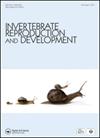Ultrastructure of spermatozoa of a hairworm Gordionus alpestris (Villot, 1885) (Nematomorpha, Chordodidae)
IF 0.8
4区 生物学
Q4 REPRODUCTIVE BIOLOGY
引用次数: 1
Abstract
ABSTRACT Sperm ultrastructure of the hairworm Gordionus alpestris (Nematomorpha, Chordodidae) was studied. Spermatozoa are elongated aflagellate cells of clavate shape. Their dilated anterior part consists of an acrosomal complex comprising an apical acrosomal vesicle and axial acrosomal tube enveloped by an acrosomal sheath of four membrane-bound compartments. The basal part of the tube contains a cluster of vesicles. The slender posterior part of the spermatozoa includes an axial nucleus without a nuclear envelope surrounded by a halo and multivesicular complex composed of cisternae arranged into three layers. Spermatozoa of G. alpestris are nearly identical in size, proportion and internal structure to those of other gordiid spermatozoa. This uniformity makes spermatozoa useless for taxon descriptions and differentiation of Gordiida. The basic pattern of spermatozoon structure in Gordiida is not fully understood and requires more detailed studies. Controversies include absence or presence of the nuclear envelope and mitochondria, together with interpretation of the halo surrounding nuclei and membranous compartments of the acrosomal and multivesicular complexes. Detailed study of sperm development together with cytochemical analysis of components such as mitochondria, acrosome, perforatorium and halo might be helpful for understanding sperm relationships of Gordiida and Nematoda.毛虫Gordionus alpestris (Villot, 1885)精子的超微结构(线虫目,脊索目)
摘要研究了长毛猴精子的超微结构。精子是细长的棒状细胞。它们扩张的前部由顶体复合体组成,顶体复合体包括顶端顶体囊泡和轴向顶体管,顶体管被四个膜结合区的顶体鞘包裹。管的基部包含一簇小泡。精子细长的后部包括一个没有核膜的轴状核,核被一个由排列成三层的池组成的晕圈和多泡复合体包围。山羊精子在大小、比例和内部结构上与其他戈氏精子几乎相同。这种一致性使得精子对高尔虫的分类单元描述和分化毫无用处。Gordiida精子结构的基本模式尚不完全清楚,需要进行更详细的研究。争议包括核膜和线粒体的缺失或存在,以及顶体和多泡复合体的核晕和膜区室的解释。对精子发育的详细研究,以及线粒体、顶体、穿孔体和晕等成分的细胞化学分析,可能有助于了解高尔虫和线虫的精子关系。
本文章由计算机程序翻译,如有差异,请以英文原文为准。
求助全文
约1分钟内获得全文
求助全文
来源期刊
CiteScore
1.90
自引率
0.00%
发文量
21
审稿时长
>12 weeks
期刊介绍:
Invertebrate Reproduction & Development ( IRD) presents original research on the reproductive and developmental biology of the Invertebrata, both embryonic and postembryonic. IRD welcomes papers reporting significant results obtained using new techniques. Encouraged topic areas include: aquaculture, physiology, biochemistry, functional morphology, phylogeny, behavioural and regulatory mechanisms, including genetic, endocrine and molecular studies. Papers containing qualitative descriptions of reproductive cycles and gametogenesis will not be considered. IRD is published in association with the International Society of Invertebrate Reproduction and Development.

 求助内容:
求助内容: 应助结果提醒方式:
应助结果提醒方式:


